Since we spend almost a third of our lives sleeping, we need to make our resting place as comfortable as possible. A pleasant interior can help you relax and forget about all the tasks outside of your bed. In this article, you’ll find ideas and tips on how to create a heavenly retreat from a small bedroom.
Choosing an interior style
When planning the interior of a living room, kitchen, or office, functionality is usually the primary consideration. However, in the relaxation area, you can let your imagination run wild and listen to your heart’s desires. Some styles that can serve as a basis for design experiments in a small bedroom include Scandinavian, modern, classic, minimalism, loft, or Provence.
Small bedroom in a modern style
A small bedroom in the 21st century features clean graphic lines, calm tones, and no extra objects.
Reserve black, chocolate, and dark blue finishes for larger rooms. Consider covering the floor with parquet, laminate, or a restrained colored carpet. Use metallic sheen, chrome handles, polished wood, and mirrors to reflect light and visually expand the space.
You can add accents like pictures, refined torchieres, ceramic figures, and indoor plants.



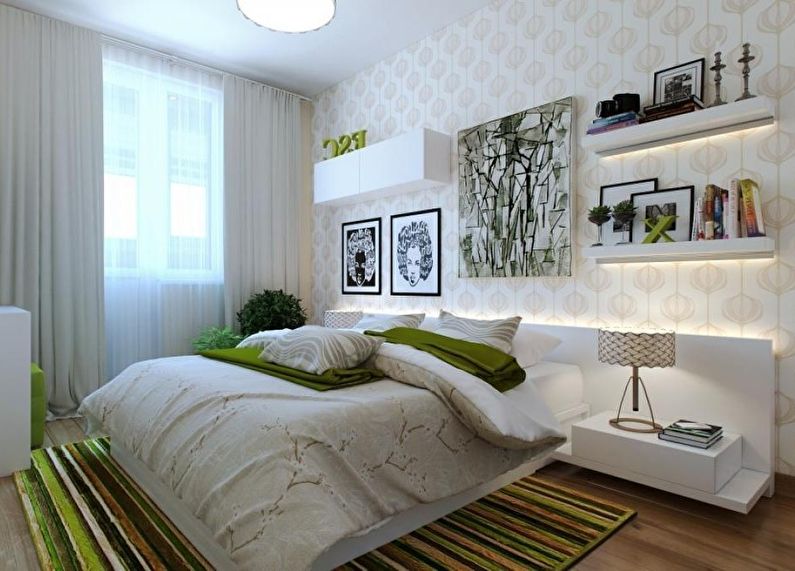
Small bedroom in a classic style
This style will be appreciated by lovers of luxury. Pastel shades of white, pink, peach, light lilac, perfectly complement aristocratic golden-silver patterns, gypsum molding, columns, and crystal chandeliers.
Carved furniture, painted with ivory enamel, will create a majestic palace atmosphere. Consider upholstering the bed headboard with soft leather. Cover windows with satin, velvet, or atlas curtains that match the color scheme. These fabrics will also be suitable for a canopy. The bedspread can be jacquard with shimmering patterns. Abundance of light in the setting will transform an ordinary small room into a truly royal one.


Small bedroom in Provence style
If you’re a romantic soul drawn to the atmosphere of southern France, the Provence style is a perfect match for you. Ensure all interior details adopt pastel shades like white-blue, pink, light purple, pale green, and beige. Choose textiles that appear sun-bleached, favoring faded calico with a small floral ornament, tiny polka dots, checks, or diamonds.
Select simple and unpretentious furniture for a small bedroom in the Provence style. This can include furniture made from light, untreated wood or pieces painted white.

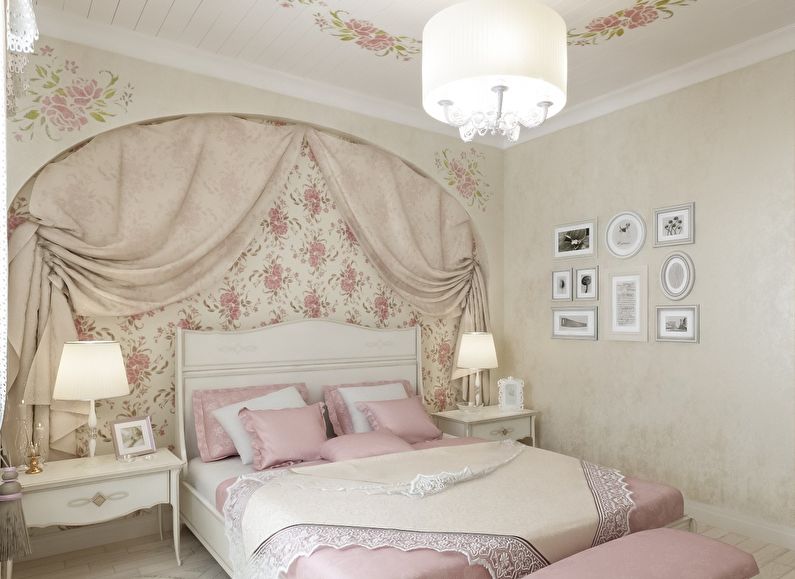


Small bedroom in Loft style
Initially, the term “loft” referred to former factories, industrial warehouses, and offices that were converted into residential spaces. They are characterized by the absence of wall finishing, lots of open space, high ceilings, and large windows. However, some ideas from this style can be useful in refreshing the interior of a small bedroom.
For example, instead of tired wallpaper or plaster, only the bare brickwork, concrete panels, or their imitation are left on the walls. A simple bed without legs is placed directly on a wooden floor.
To visually enlarge the room, you can expand the window, turning it into a panoramic one, and order a wardrobe with glossy metallic doors. In a loft, blinds or simple curtains with vertical folds should replace traditional curtains.


Small bedroom in Minimalist style
This is the most optimal option for a small bedroom. It completely lacks any excesses – no curls, patterns, decorations, or embellishments. One or two close or contrasting colors in the design, perfectly smooth surfaces, clear furniture, and simple geometric-shaped lamps – all of this saves a lot of space. Such a simple and modern solution will appeal to business people with a rational approach to life.
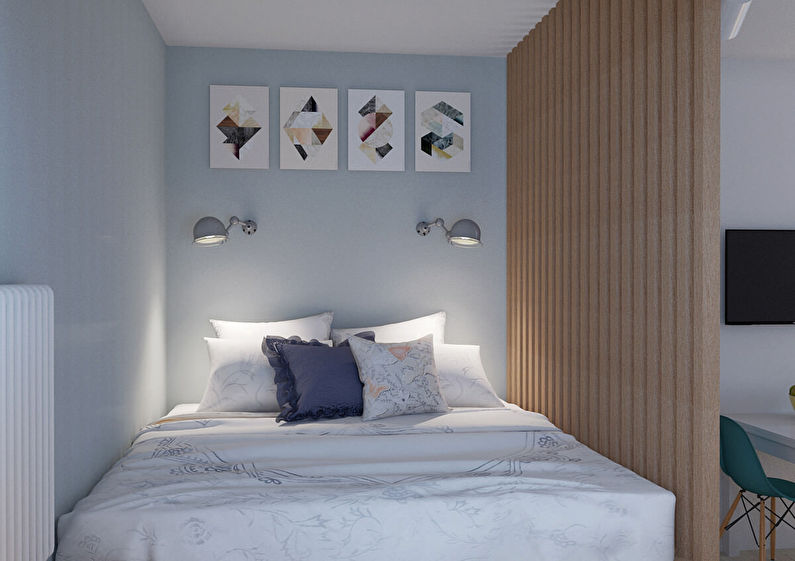


The first association with Scandinavia is transparency and coolness. Decoration in airy white tones with light brown or gray-blue accents is best suited for rooms facing south, as well as those located in warm climates. Such finishing will help to cope with heat more easily, create a feeling of freshness and lightness. The bedroom in Scandinavian style should remind of snowy mountain peaks and icy rivers.



Color solutions
Since we are talking about small bedrooms, the main attention should be focused on a light palette. Colors close to white reflect more light and visually expand the space.
Small bedroom in white
It’s no coincidence that nature itself chose this color to cover the sleeping earth in winter: it lulls, relaxes, creates an atmosphere of purity and tranquility. In a completely snowy white room, sleep will come in just a few minutes, and if you want to add romance, just use colored lighting.



Small bedroom in blue tones
Decoration in heavenly shades relieves nervous tension and cools the body. It will be appropriate if the apartment often gets hot. For active, energetic people, this color will help to dissipate energy a little and enjoy dreams.



Small bedroom in green tones
Herbal, salad, emerald, sea – they all create a feeling of freshness, provide a desired rest for the eyes and the nervous system. This is the easiest color to perceive, as it is right in the middle of the rainbow spectrum.
Green is the color of life, and it should be combined in the bedroom with calm natural shades such as gray, brown, sandy-yellow, turquoise, or lavender.


Small bedroom in purple tones
Soft purple tone appears in the sky in the evening after sunset. It envelops the horizon with a light haze and as if invites you to a fairytale dreamland. In the bedroom, it can be a beautiful addition to green, yellow, or pink elements. Purple also looks harmonious with white, beige, and cream colors.


Small Bedroom in Yellow Tones
This sunny color is perfect for a bedroom that lacks warmth. Sand, lemon, saffron, and golden tones will make the room bright and warm. Shades of yellow uplift the mood and bring joy to life, and they go best with white, green, blue, purple, or brown.
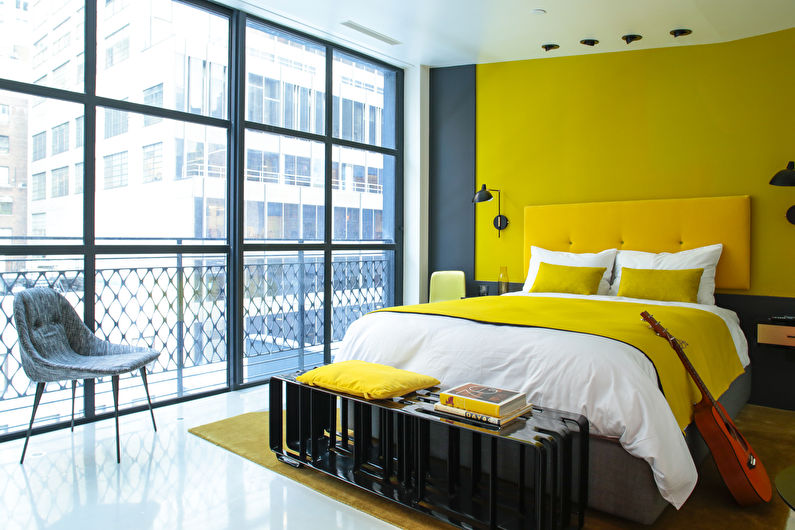

A small bedroom in gray tones
Gray is the calmest and most neutral color. It is much softer than black, so it won’t look bulky. It is a wonderful background for any bright accents, and it itself has simplicity and restraint. Light or silver shades of gray are suitable for all interior styles.


Finishing and Materials
The choice of materials for finishing the bedroom is almost unlimited. The humidity in this room is normal, and the impact of ultraviolet rays and other factors is minimal. The only important condition that should not be overlooked is the safety of materials: they should not contain harmful additives or emit toxic vapors.
Floor
The bedroom floor is better made of warm material. It can be wooden parquet, laminate, or carpet. To make the space look more voluminous, it is advisable to avoid dark and non-uniform colors and lay the boards or other vertical patterns perpendicular to the window. The carpet should blend in with the main color or completely cover the room, otherwise it will reduce it.

Walls
The optimal choice for a small bedroom is light walls, either solid or with a small, almost imperceptible pattern. This can be achieved with whitewashing, painting, decorative plaster, wallpaper, wooden panels, or cork coating.
For a loft style, it is better to choose a white or grayish brickwork.


Ceiling
To visually make the bedroom higher, the ceiling should be glossy. It’s good if it reflects light from side sconces. A volumetric effect can be achieved by installing a mirrored stretch film in a frame made of drywall.
For a romantic design, a ceiling in the form of a blue or starry sky, with a cosmic 3D pattern and shimmering elements in the dark, would be suitable. It’s better to avoid images of planets, large figures, and saturated tones in the design of a small bedroom.
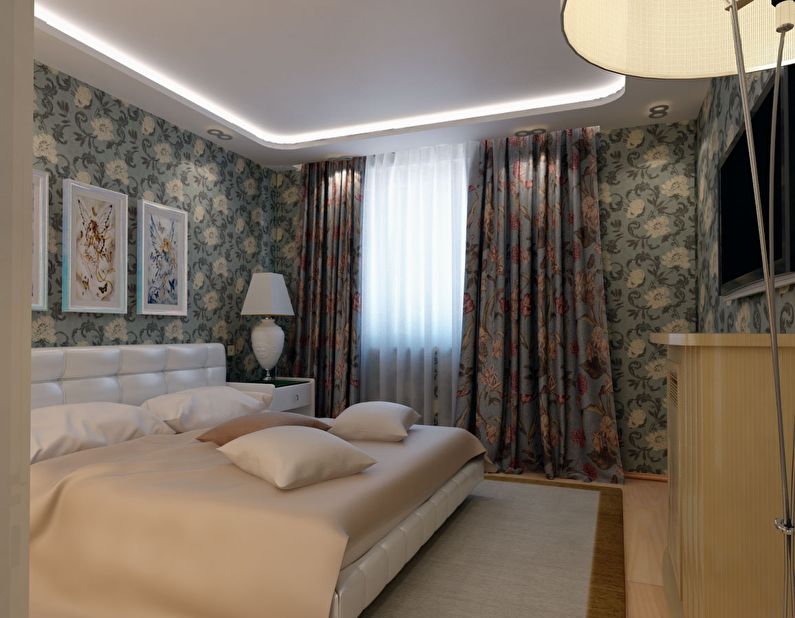

Textile
The choice of fabrics should be coordinated with the overall style. However, in any case, they should not be dark and contain large prints. It’s better to buy lightweight, airy curtains made of synthetic fabrics.
In a small bedroom, monochromatic bedding in diluted white or gray shades will look better. To ensure comfortable sleep, it’s best to prefer high-quality natural fabrics made of cotton, silk, or linen.

Furniture, Appliances, and Accessories Placement
Once the bedroom’s finishing touches are done and it looks more spacious, it’s time to think about how to best utilize its actual area. Each type of room has its own recommendations and peculiarities.
Small square bedroom
If all sides have the same length, there are no particular issues. For example, the bed can be placed in the center with the headboard against a solid or furniture wall, tall dressers or wardrobes on the sides, and a wardrobe closet on the other wall. A raised platform with pull-out shelves inside can help save space and store clothes, bedding, and various household items.


Narrow Small Bedroom
To visually balance the room, it’s recommended to apply wallpaper with three-dimensional perspective on the long wall and install a glossy surface wardrobe on the opposite wall. Narrow walls can be widened with horizontal stripes, which can be not only drawn but also functional, such as shelves in a wide bookcase.



Small Bedroom with Non-Standard Layout
Attic rooms, corners left after zoning or remodeling, and lofts converted from non-residential spaces have unusual layouts. You can use interesting furniture in such rooms like round, oval, or triangular beds, dressers with slanted edges, non-standardly configured wardrobes, hammocks, and suspended shelves.This approach will provide not only comfort and convenience but also give the bedroom interior a unique, one-of-a-kind look.


Lighting
In the sleep zone, it’s better to avoid bright overhead lighting and large hanging chandeliers. To create a soft atmosphere, a few spotlights on the ceiling, wall sconces, and one or two convenient floor lamps on bedside tables will suffice.
Light-reflecting particles or golden patterns in the wall decor can add additional flickering.


Designing a Small Bedroom
In typical apartments, the bedroom area is usually small. However, it’s entirely possible to accommodate the necessary furniture and accessories for sleeping.
You can achieve this by installing a platform bed, extending wardrobes up to the ceiling, organizing storage space under the bed, and expanding the windowsill to transform it into an additional workspace or a small vanity.
In children’s bedrooms, it makes sense to use bunk beds and foldable structures.

Combining with Other Rooms
In tight apartments, expanding a small bedroom by merging it with adjacent rooms can be a good solution.
Combining a Small Bedroom with a Living Room
Usually, this option is useful when dividing a studio into a living room and a bedroom. You can easily close off the sleeping area from prying eyes using a canopy, a screen, or a tall wardrobe, or you can place it behind a partition made from drywall or plywood.



Combining a Small Bedroom with a Balcony or Loggia
Having access from the bedroom to a balcony or loggia provides an opportunity to increase the useful area. You can remove the window and door and insulate the area facing the courtyard as much as possible by installing modern double-glazed windows.


Small Bedrooms – Photos
Our photo gallery will help you find interesting solutions for designing a small bedroom. The photos show the most successful options for finishing, furniture placement, and decor. Get inspired!


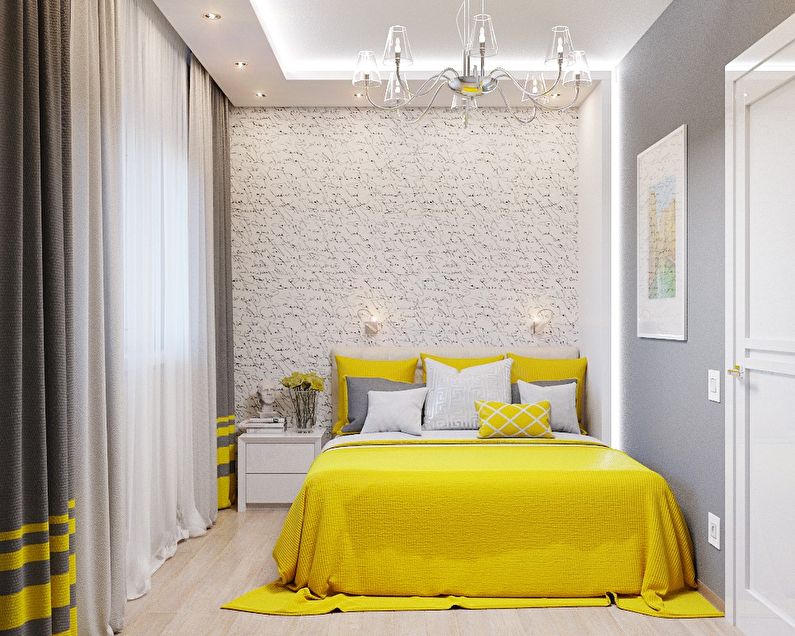












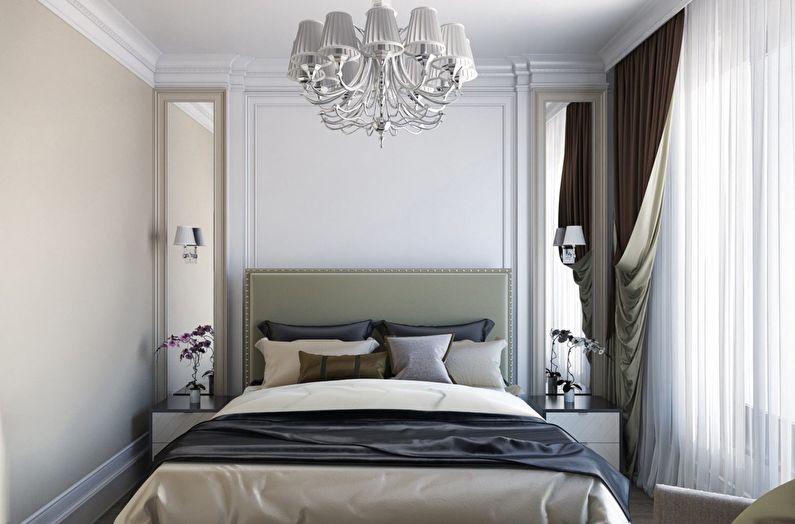






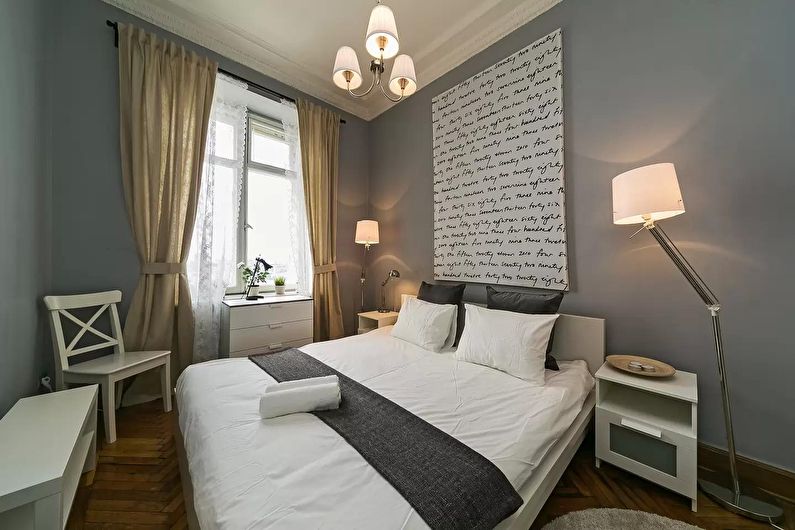










Leave feedback about this